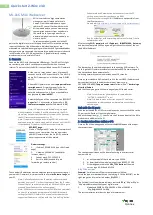
Option
Description
Deactivate
, the TPM is disabled and deactivated. When set to
Clear
, all the contents of
the TPM are cleared. This option is set to
None
by default.
When TPM 2.0 is installed, the
TPM Security
option is set to
On
or
Off
. This option is set to
Off
by default.
TPM 2.0 security information
TPM Information
Changes the operational state of the TPM. This option is set to
No Change
by default.
TPM Firmware
Indicates the firmware version of the TPM.
TPM Hierarcy
Enable, disable, or clear the storage and endorsement hierarchies. When set to
Enabled
,
the storage and endorsement hierarchies can be used.
When set to
Disabled
, the storage and endorsement hierarchies cannot be used.
When set to
Clear
, the storage and endorsement hierarchies are cleared of any values,
and then reset to
Enabled
.
Intel(R) TXT
Enables or disables the Intel Trusted Execution Technology (TXT) option. To enable the
Intel TXT
option,
virtualization technology and TPM Security must be enabled with Pre-boot measurements. This option is set to
Off
by default.
When TPM 2.0 is installed,
TPM 2 Algorithm
option is available. It enables you to select a hash algorithm from
those supported by the TPM (SHA1, SHA256).
TPM 2 Algorithm
option must be set to
SHA256
, to enable TXT.
Power Button
Enables or disables the power button on the front of the system. This option is set to
Enabled
by default.
AC Power Recovery
Sets how the system behaves after AC power is restored to the system. This option is set to
Last
by default.
AC Power Recovery
Delay
Sets the time delay for the system to power up after AC power is restored to the system. This option is set to
Immediate
by default.
User Defined Delay
(60 s to 240 s)
Sets the
User Defined Delay
option when the
User Defined
option for
AC Power Recovery Delay
is selected.
UEFI Variable
Access
Provides varying degrees of securing UEFI variables. When set to
Standard
(the default), UEFI variables are
accessible in the operating system per the UEFI specification. When set to
Controlled
, selected UEFI variables are
protected in the environment and new UEFI boot entries are forced to be at the end of the current boot order.
In-Band
Manageability
Interface
When set to
Disabled
, this setting will hide the Management Engine's (ME), HECI devices, and the system's IPMI
devices from the operating system. This prevents the operating system from changing the ME power capping
settings, and blocks access to all in-band management tools. All management should be managed through out-of-
band. This option is set to
Enabled
by default.
NOTE:
BIOS update requires HECI devices to be operational and DUP updates require IPMI interface to
be operational. This setting needs to be set to Enabled to avoid updating errors.
Secure Boot
Enables Secure Boot, where the BIOS authenticates each pre-boot image by using the certificates in the Secure
Boot Policy. Secure Boot is set to
Disabled
by default.
Secure Boot Policy
When Secure Boot policy is set to
Standard
, the BIOS uses the system manufacturer’s key and certificates to
authenticate pre-boot images. When Secure Boot policy is set to
Custom
, the BIOS uses the user-defined key and
certificates. Secure Boot policy is set to
Standard
by default.
Secure Boot Mode
Configures how the BIOS uses the Secure Boot Policy Objects (PK, KEK, db, dbx).
If the current mode is set to
Deployed Mode
, the available options are
User Mode
and
Deployed Mode
. If the
current mode is set to
User Mode
, the available options are
User Mode
,
Audit Mode
, and
Deployed Mode
.
38
Pre-operating system management applications
















































